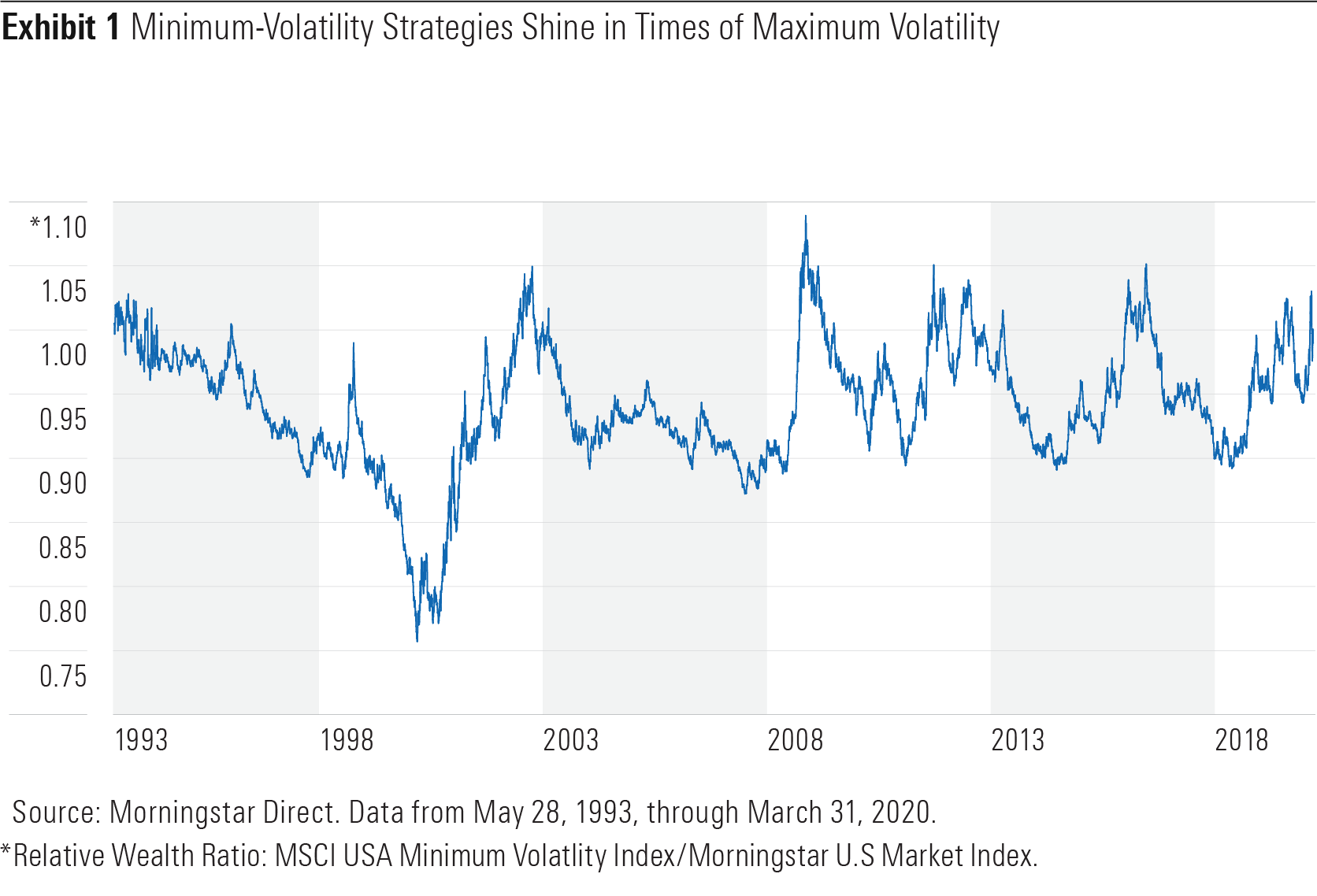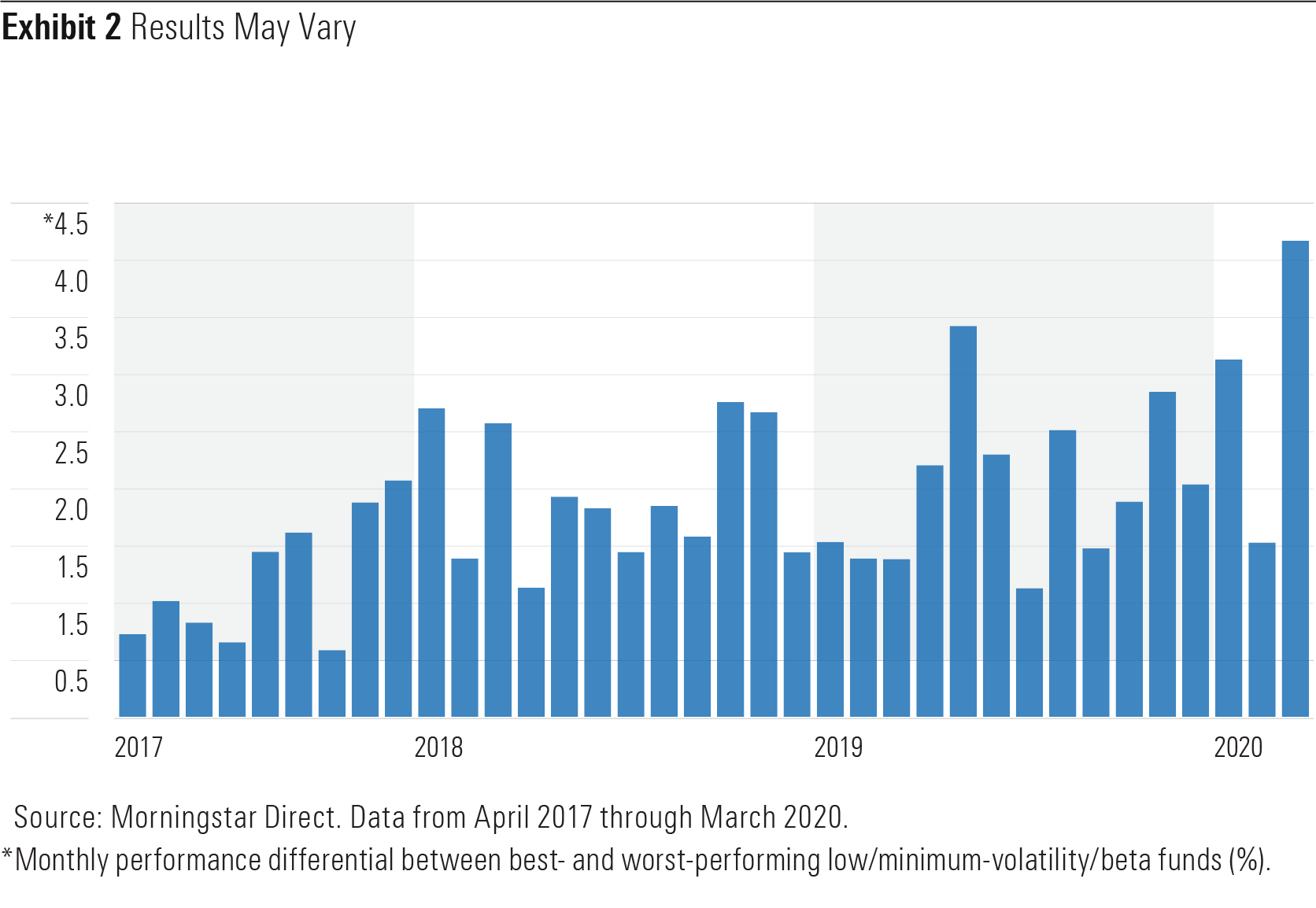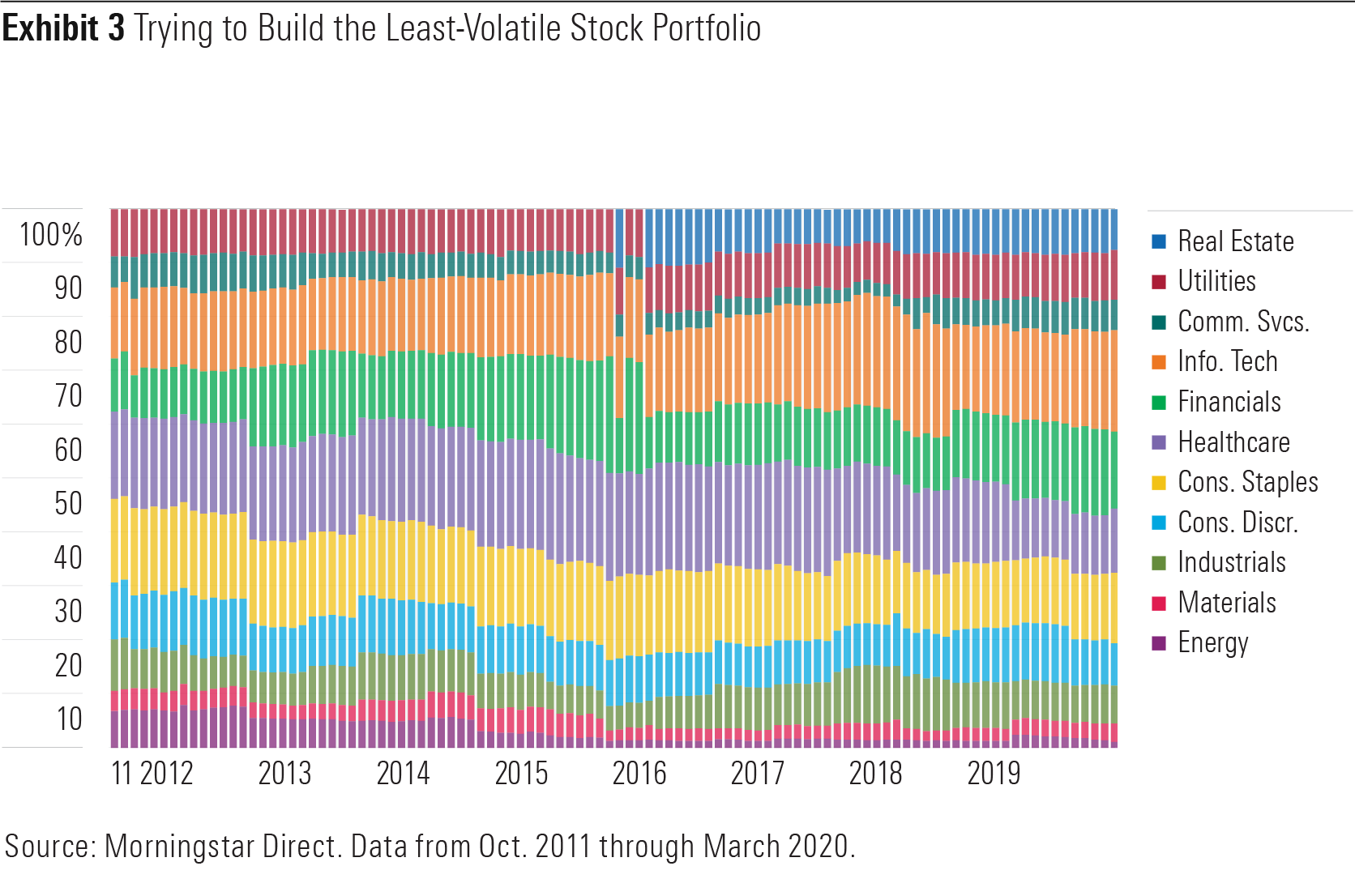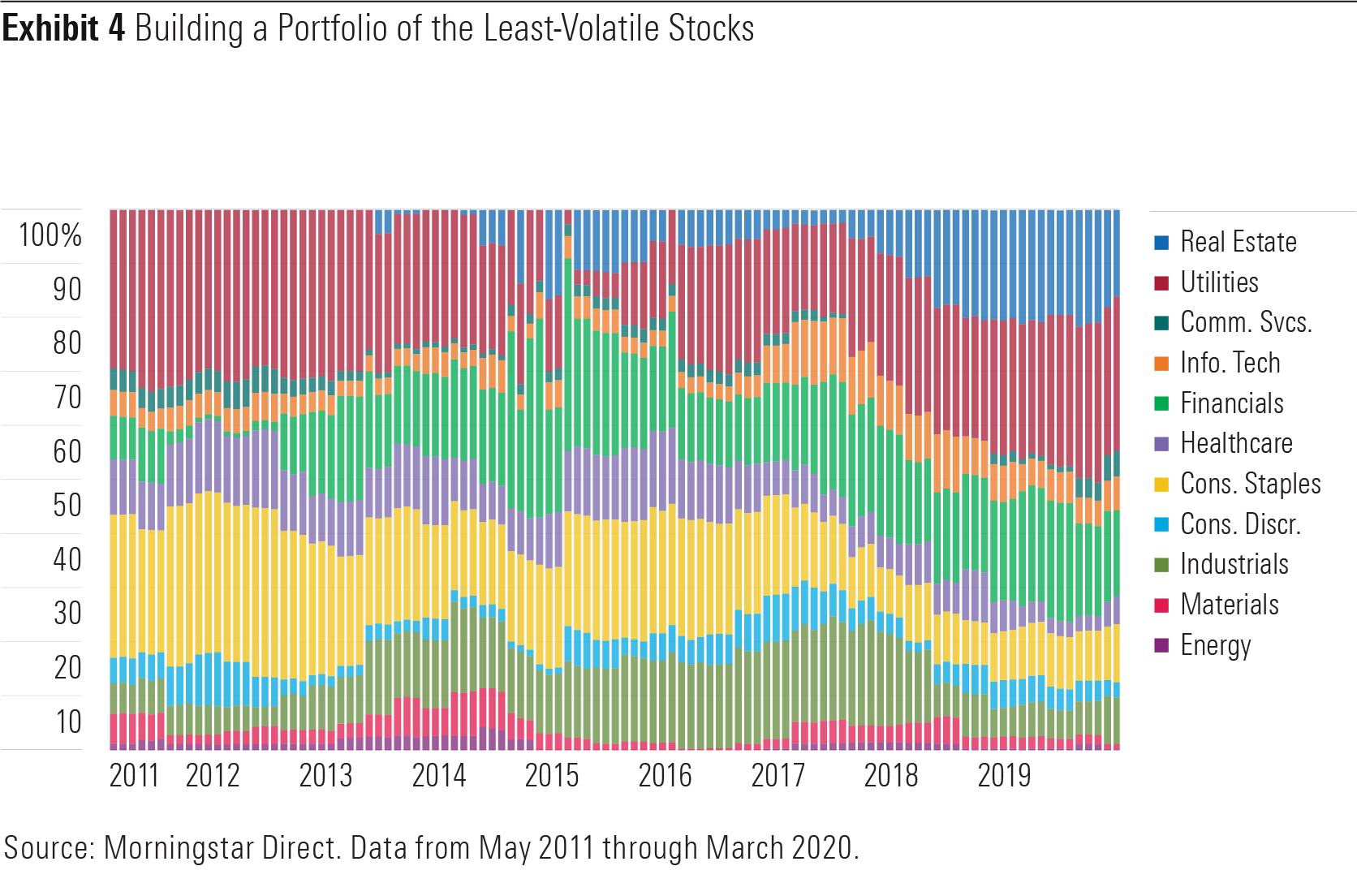Low Volatility Doesn't Mean No Volatility
A look at how low-volatility ETFs weathered the recent storm.
Editor's note: Read the latest on how the coronavirus is rattling the markets and what investors can do to navigate it.
A version of this article appeared in the April 2020 issue of Morningstar ETFInvestor. Click here to download a copy.
Low-volatility exchange-traded funds aim to give investors a smoother ride in stock markets. Being long stocks with less risk is a compelling proposition. So it's little surprise that these funds have been popular. Over the three years through February 2020, investors poured a combined $23.8 billion of their hard-earned savings into the eight U.S. large-cap ETFs that focus on dialing down volatility. This represented 125% organic growth over that three-year stretch. But the recent market meltdown has put these funds to the test, and some investors have gotten spooked. These funds saw $1.9 billion in net outflows in March.
Here, I'll look at how low-volatility ETFs have performed in the market downdraft, examine the differences among them, and share my thoughts on how investors might use them to manage risk.
The Best of One World Low-volatility strategies are at their best when markets are at their worst. Exhibit 1 is a relative wealth chart that plots the growth of the MSCI USA Minimum Volatility Index divided by the growth of the Morningstar U.S. Market Index. When the line slopes upward, the minimum-volatility index is outperforming the broad market index and vice versa. The upward spikes coinciding with the bursting of the dot-com bubble, the global financial crisis, and the current coronavirus pandemic are a testament to the strategy's efficacy--it has taken some of the sting out of stock market drawdowns.

But there are trade-offs. Investors can't have the best of both worlds. Low-volatility strategies will tend to lag during bull markets. This is most evident in the sharp downward slope of the line that spans the better part of the 1990s.
Over the long term, investors in low-volatility strategies are betting that this trade-off between losing less on the downside and not gaining as much on the upside will result in marketlike returns with less risk. The nearly three decades of performance history illustrated in Exhibit 1 show that has generally been a solid bet--over a long enough horizon.
Weathering the Storm How have low-volatility ETFs weathered the recent storm? In a word: differently.
We currently assign Morningstar Analyst Ratings to two of the eight U.S. large-cap low-volatility ETFs. Invesco S&P 500 Low Volatility ETF SPLV is rated Bronze, and iShares Edge MSCI USA Minimum Volatility ETF USMV has a Silver rating. During the recent sell-off, USMV's maximum drawdown (the depth of its decline from its mid-February peak) was 33.1%. SPLV's maximum drawdown was 36.3%. Gold-rated iShares Core S&P Total U.S. Stock Market ETF ITOT--a proxy for the broader U.S. market--experienced a maximum drawdown of 35.0%. USMV performed as expected during this episode; SPLV did not. Investors should not expect these funds to bat 1.000, outperforming the market each time it dips. The longer the time frame, the more likely it is you'll see this relationship hold. In fact, as of the end of March, both funds had outperformed ITOT on a year-to-date basis, posting more-modest losses.
This underscores two key points that investors must keep in mind when assessing the merits of these funds and deciding where they might fit within their portfolios: 1) Results may vary from fund to fund. 2) Low volatility does not mean no volatility, just less.
Results May Vary There are important, albeit nuanced, differences in the way low-volatility strategies are constructed. The disparity in USMV and SPLV's recent performances is a testament to that. Exhibit 2 provides further evidence. It shows the absolute value of the spread in the monthly performance of the best- and worst-performing funds among the eight U.S. large-cap low-volatility ETFs over the three years through March.
The Case of USMV Versus SPLV In the case of USMV and SPLV, these differences point back to the funds' overarching approach to portfolio construction. USMV attempts to build the least-volatile portfolio of stocks it can, choosing from the MSCI USA Index. SPLV's portfolio is made up of the 100 least-volatile stocks from the S&P 500. There's a distinction between combining stocks to form the least-volatile portfolio versus building a portfolio of the least-volatile stocks. At first blush, it may seem trite, but the complexion of these funds' portfolios is markedly different.

Exhibits 3 and 4 show the evolution of the funds' GICS sector exposures. The comparison illustrates the differences in their approaches. USMV's sector exposures are relatively stable. This is because its index tethers its sector weightings to those of its parent index. They can't stray more than 5% in either direction from this reference point. SPLV has no such restrictions in place, which can lead to large and persistent sector bets.


At the height of the market in mid-February, utilities and real estate stocks made up nearly 47% of SPLV's portfolio. At that time, stocks from those same two sectors represented just 17% of USMV's portfolio. SPLV's exposures in these sectors explained just over half of its relative underperformance versus USMV from the mid-February peak to the late-March trough.
Methodological differences between these seemingly similar funds are important to understand, as they can lead to material differences in their long-term risk and return profiles.
Less Volatility Low volatility does not mean no volatility, just less. Low-volatility stock funds are still stock funds. They are designed to be less volatile than their selection universes, and there's no question that they have delivered based on that criterion. But it can be dangerous to equate "less" volatility with "low" volatility. The former is a more apt description, and one that would better calibrate investors' expectations. The latter better describes assets that would better diversify equity risk, like high-quality bonds.
The most promising feature of these funds is that they could--in theory--help investors stay in the market during trying times, dulling the pain they experience each time they check the value of their portfolio. But I'm deeply skeptical that they can serve that function. I don't think most investors take comfort in losing relatively less when the market hits an air pocket.
Investors need to understand that while these funds may have a place in their risk-management tool kit, they are specialized implements. Less-volatile equity portfolios may have a place, but they rank well below setting aside a rainy-day fund, having an appropriate asset allocation, and going for a walk outside the next time you're tempted to tinker with your portfolio.
Disclosure: Morningstar, Inc. licenses indexes to financial institutions as the tracking indexes for investable products, such as exchange-traded funds, sponsored by the financial institution. The license fee for such use is paid by the sponsoring financial institution based mainly on the total assets of the investable product. Please click here for a list of investable products that track or have tracked a Morningstar index. Neither Morningstar, Inc. nor its investment management division markets, sells, or makes any representations regarding the advisability of investing in any investable product that tracks a Morningstar index.

/s3.amazonaws.com/arc-authors/morningstar/a90ba90e-1da2-48a4-98bf-a476620dbff0.jpg)
/d10o6nnig0wrdw.cloudfront.net/04-18-2024/t_34ccafe52c7c46979f1073e515ef92d4_name_file_960x540_1600_v4_.jpg)
/d10o6nnig0wrdw.cloudfront.net/04-09-2024/t_e87d9a06e6904d6f97765a0784117913_name_file_960x540_1600_v4_.jpg)
/cloudfront-us-east-1.images.arcpublishing.com/morningstar/T2LGZCEHBZBJJPPKHO7Y4EEKSM.png)
:quality(80)/s3.amazonaws.com/arc-authors/morningstar/a90ba90e-1da2-48a4-98bf-a476620dbff0.jpg)